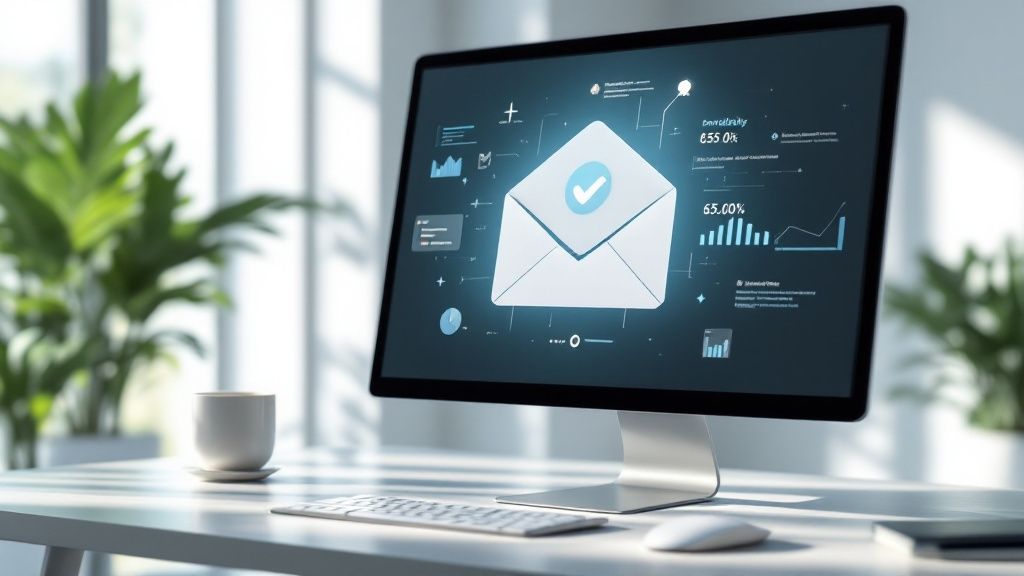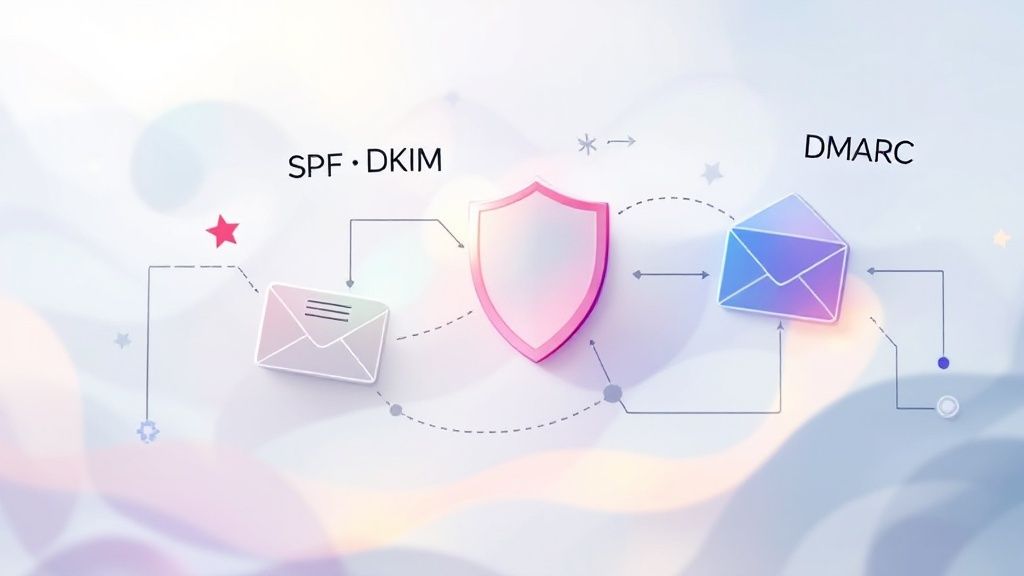How to Increase Email Deliverability: Proven Tips
April 13, 2025

Understanding the Deliverability Landscape

Before delving into the specifics of increasing email deliverability, it's important to understand the factors that contribute to a successful email campaign. Deliverability isn't just about your email reaching a server; it's about landing in the inbox. It's similar to sending a letter: delivery confirmation doesn't guarantee it's been read.
The Role of Mailbox Providers
Major mailbox providers like Gmail, Yahoo, and Outlook employ sophisticated algorithms to filter incoming emails. These algorithms act as gatekeepers, determining which messages reach the inbox and which are filtered as spam. Understanding how these gatekeepers function is crucial for your email marketing success. For instance, a high volume of spam complaints can damage your sender reputation, impacting your deliverability.
Key Factors Affecting Deliverability
Several interconnected factors determine your email's deliverability. Engagement metrics, such as open and click-through rates, demonstrate recipient interest and boost your sender reputation. Low engagement, conversely, suggests your emails are unwanted.
Content quality is also paramount. Emails containing spam-triggering words or phrases can be flagged, regardless of your list quality or authentication. A balanced, strategic approach to all deliverability aspects is essential.
Regional Differences in Email Deliverability
Another critical factor is understanding regional variations in deliverability. Globally, inbox placement rates differ. Europe boasts high rates, reaching up to 91%, while the Asia Pacific region sees lower rates around 78%.
Specifically, Germany and the UK have impressive deliverability rates of 97.8% and 98.8%, respectively, according to recent data. These differences underscore the need to tailor email strategies to each region, considering local anti-spam legislation and consumer behavior. North America, for example, has a deliverability rate of 87.9%, influenced by regulations like CAN-SPAM in the U.S.. Understanding these regional nuances allows marketers to optimize campaigns for better reach. More detailed statistics can be found here: https://www.validity.com/wp-content/uploads/2023/03/2023-Email-Deliverability-Benchmark.pdf
For further information on improving email deliverability, you might find this resource helpful: How to Master Email Deliverability. By understanding these fundamentals, you'll be equipped to make informed decisions that significantly improve your email deliverability, moving beyond short-term fixes.
Authentication Protocols: Your Deliverability Foundation

Email authentication is essential for a solid sender reputation and high deliverability. It's like a digital signature, verifying your identity and protecting your emails from being marked as spam. This section explores the key authentication protocols: SPF, DKIM, and DMARC.
SPF (Sender Policy Framework)
SPF acts as a gatekeeper for your domain. It designates which mail servers are permitted to send emails on your behalf. This prevents spammers from forging your sender address and harming your reputation.
For instance, if a server tries sending an email appearing to be from your domain but isn't on your SPF record, mailbox providers will likely reject or flag it. This acts as the first line of defense against spoofing.
DKIM (DomainKeys Identified Mail)
DKIM gives your outgoing emails a unique encrypted signature, verifying that the content remains unaltered during transit. Think of it as a tamper-proof seal, guaranteeing the integrity of your emails.
DKIM works by placing a digital signature in your email header, which mailbox providers verify against your domain's public key. This adds another layer of trust, confirming the email's origin.
DMARC (Domain-based Message Authentication, Reporting, and Conformance)
DMARC builds on SPF and DKIM, giving you greater control over how email providers handle messages that fail authentication. You can choose to quarantine these emails in spam or reject them entirely.
DMARC also provides valuable reporting data, letting you track authentication failures and spot potential problems. Implementing DMARC is crucial for boosting email deliverability. In 2024, almost 54% of surveyed senders used DMARC, an 11% increase from the previous year. This growth highlights the rising importance of email authentication in fighting spoofing and phishing. Learn more about email authentication and deliverability insights here: Mailgun Blog.
Working Together: A Powerful Combination
These three protocols work together to enhance your deliverability. SPF authorizes sending sources, DKIM validates message integrity, and DMARC provides enforcement and reporting. With major email platforms like Gmail and Yahoo enforcing stricter authentication, implementing these protocols is vital.
To illustrate the core functions and implementation of these protocols, let's look at a comparison table:
Email Authentication Protocols Comparison: This table compares different email authentication protocols, their functions, and how complex they are to implement.
| Protocol | Primary Function | Implementation Complexity | Impact on Deliverability |
|---|---|---|---|
| SPF | Authorizes sending mail servers | Relatively simple | Improves deliverability by preventing spoofing |
| DKIM | Verifies message integrity | Moderate complexity | Strengthens sender reputation and reduces spam filtering |
| DMARC | Enforces authentication policies and provides reporting | More complex, builds on SPF and DKIM | Significantly enhances deliverability by preventing fraudulent emails |
By correctly implementing these protocols, you establish credibility as a legitimate sender, boosting your inbox placement rate and maximizing the impact of your email campaigns.
Selecting an ESP That Powers Your Deliverability
Your Email Service Provider (ESP) is much more than a simple email sending platform. It's the very core of your email deliverability strategy. Choosing the right ESP can be a huge advantage, while the wrong choice can seriously hinder your efforts before your emails even leave the server. This section will guide you through the process of evaluating and selecting an ESP to boost your chances of landing in the inbox.
Infrastructure Quality and Compliance Standards
Leading ESPs like Mailchimp and SendGrid make significant investments in robust infrastructure, specifically built for optimal email deliverability. This involves maintaining high sender scores, complying with rigorous compliance standards, and employing dedicated teams to constantly monitor and manage sender reputation. These providers also proactively work with major mailbox providers like Gmail and Outlook to ensure their customers' emails are given priority. It's similar to selecting a reliable shipping company: you need a provider with a proven track record and a strong delivery network.
Deliverability Support and Tools
Top-tier ESPs offer more than just sending functionalities. They provide a suite of tools and resources specifically designed to support your deliverability goals. Look for providers that offer real-time monitoring, in-depth analytics, and readily available expert support. This will help you troubleshoot any deliverability problems and fine-tune your email campaigns for the best results. Some ESPs even provide dedicated deliverability consultants for personalized guidance.
The Importance of ESP Relationships
A strong ESP will have nurtured positive relationships with major mailbox providers. These relationships are crucial for better inbox placement for their clients. They are built on mutual trust and consistent adherence to email best practices. Choosing an ESP with these established connections can dramatically increase your email deliverability.
To illustrate the impact of ESP choice on deliverability, let's look at some data. In 2024, top ESPs included ActiveCampaign with a deliverability rate of 94.2%, followed by Constant Contact at 91.7%, and GetResponse at 90.9%. Conversely, some ESPs like Aweber (83.1%) and Benchmark (47.1%) faced lower rates. This data underscores the importance of selecting the right ESP, alongside maintaining good list hygiene and creating engaging content.
To explore these statistics further, take a look at this resource: EmailToolTester Blog. It provides valuable insights into email deliverability trends and best practices.
To better understand the varying performance, let's examine a comparison table:
ESP Deliverability Performance Comparison
Comparison of top email service providers and their deliverability rates
| Email Service Provider | Deliverability Rate | Key Strengths | Best For |
|---|---|---|---|
| ActiveCampaign | 94.2% | Automation, CRM integration | Businesses focused on sales and marketing automation |
| Constant Contact | 91.7% | Ease of use, email marketing templates | Small businesses and nonprofits |
| GetResponse | 90.9% | All-in-one marketing platform, landing pages | Businesses looking for a comprehensive marketing solution |
| Aweber | 83.1% | Email automation, segmentation | Small to medium-sized businesses |
| Benchmark | 47.1% | Simple interface, affordable pricing | Businesses with basic email marketing needs |
As you can see, deliverability rates and strengths vary among ESPs. Choosing the right provider for your specific needs is key to achieving your email marketing goals.
Red Flags to Watch Out For
When evaluating ESPs, beware of providers that focus on quantity over quality. Some red flags to look out for include a lack of transparent deliverability reporting, insufficient support resources, and lenient policies regarding list acquisition. These are potential signs that an ESP may be putting your sender reputation at risk.
Making the Right Choice
Whether it’s your first ESP or you're thinking of switching providers, prioritize deliverability from the beginning. By selecting an ESP that focuses on inbox placement and gives you the tools to succeed, you're setting yourself up for long-term email marketing success.
Building a List That Providers Actually Trust
Effective email deliverability isn't solely about technical setup; it hinges on the quality of your email list. Many deliverability problems stem from sending emails to unengaged recipients or those who haven't explicitly opted in. This section explores how to cultivate a list that fosters trust with mailbox providers, boosting your chances of reaching the inbox.
Permission-Based Acquisition: Going Beyond the Checkbox
Securing genuine subscriber interest is crucial. This means exceeding basic compliance. Permission-based acquisition entails obtaining clear, explicit consent before adding someone to your list. It’s about respecting their inbox.
-
Offer valuable content: Provide enticing lead magnets like exclusive guides, insightful reports, or free webinars in exchange for email addresses.
-
Be transparent about email frequency: Manage expectations by clearly stating how often subscribers will receive emails.
-
Segment your audience from the outset: Offer choices about email types. A clothing retailer, for instance, could segment by men's wear, women's wear, or sale alerts.
List Hygiene: Maintaining a Healthy List
Like a garden, your email list needs regular tending. List hygiene means actively managing your subscribers to remove inactive or unengaged contacts.
-
Engagement Segmentation: Regularly segment your list by engagement metrics. Identify those who haven't opened or clicked your emails recently.
-
Bounce Handling: Monitor bounce rates. Hard bounces, signaling permanent delivery failures, require immediate removal. Soft bounces, indicating temporary issues, require monitoring, and repeated soft bounces warrant removal.
-
Strategic Sunsetting: A sunset policy automatically removes inactive subscribers after a defined period, like six months or a year.
Double Opt-In: Confirmation and Quality
Double opt-in adds a confirmation step: subscribers verify their address by clicking a link in a confirmation email. While it may slightly reduce initial sign-ups, it substantially improves list quality.
-
Reassurance and Clarity: Use the confirmation email to reiterate the value subscribers will receive.
-
Optimize the Confirmation Process: Ensure prompt delivery of the confirmation email with a clear, easy-to-click confirmation link.
Revival Campaigns: Re-Engaging Dormant Subscribers
Before removing inactive subscribers, consider revival campaigns. These targeted emails aim to re-engage dormant subscribers without triggering spam filters.
-
Personalized Messaging: Craft compelling emails reminding subscribers why they joined and offering exclusive incentives to re-engage.
-
Test and Iterate: Monitor revival campaign results, adjusting based on open and click-through rates.
By prioritizing these strategies, you can build a high-quality email list that mailbox providers recognize as engaged and receptive. This, in turn, enhances email deliverability, ensuring your messages reach the inbox and contribute to your marketing success.
Crafting Content That Avoids Spam Trigger Points

Even with a legitimate email list and strong authentication, your emails can still be marked as spam. This happens if the content triggers spam filters. This section explains how to write engaging email content that resonates with your audience and reaches their inbox. Mastering this balance is crucial for successful email marketing.
Identifying and Avoiding Spam Triggers
Today's spam filters are complex. They analyze many content elements to identify potentially unwanted messages. Understanding these triggers is crucial for maintaining high email deliverability.
-
Subject Line Red Flags: Avoid overuse of ALL CAPS, exclamation points, and phrases like "free money" or "guaranteed win." Write concise, intriguing subject lines that accurately reflect your email's content.
-
Text-to-Image Ratio: Visuals are important, but image-heavy emails with minimal text can trigger spam filters. Aim for a balance between visuals and informative text.
-
Code Structure Issues: Messy HTML code can also be a problem. Use clean, validated code to ensure your emails display correctly in different email clients. This is especially important for improving deliverability.
Email Client Rendering and Engagement
How your email appears in different email clients significantly impacts engagement. A positive user experience leads to more opens and clicks, which improves your sender reputation.
-
Device Optimization: Make sure your emails are responsive and display correctly on desktops, mobile devices, and tablets. A consistent user experience, regardless of device, encourages higher engagement.
-
Image Blocking: Many email clients block images by default. Use descriptive alt text for your images so recipients know what they're missing. This improves the user experience and encourages them to enable images.
Compelling Calls-to-Action That Don't Trigger Filters
Your calls-to-action (CTAs) drive conversions. However, aggressive or misleading CTAs can hurt your email deliverability.
-
Clear Value Proposition: Focus on the value you offer. A compelling CTA that aligns with the email content is more effective and less likely to trigger spam filters.
-
Button Best Practices: Use clear, concise button text that encourages action. Avoid generic phrases like "click here." Instead, use action words like "Shop Now" or "Learn More."
Testing and Optimization for Continuous Improvement
Testing emails before sending is crucial. Catch potential deliverability issues before they affect your sender reputation.
-
Preview Across Email Clients: Use email testing tools like Litmus or Email on Acid to see how your emails render in various clients and on different devices. This ensures consistent display and helps you find formatting problems.
-
A/B Test Subject Lines: A/B testing helps you find the best-performing subject lines, improving open rates and protecting your email deliverability.
By following these content strategies, you can create engaging emails that reach the inbox and drive results. Balancing effective marketing with deliverability best practices is a continuous process of improvement.
Monitoring Systems That Protect Your Reputation

Proactive monitoring is key to maintaining a healthy email program and maximizing deliverability. It's the difference between reacting to problems and preventing them. This section explores the essential monitoring systems you need to safeguard your sender reputation and ensure your emails consistently land in the inbox.
Implementing and Interpreting Seed Testing
Seed testing is a valuable method for understanding how mailbox providers handle your emails. It involves sending test emails to a controlled list of addresses across various platforms like Gmail and Outlook. By analyzing the results, you can gauge your inbox placement rate and catch deliverability issues early. For example, a sudden drop in inbox placement during seed tests could indicate a problem with your content or a shift in a provider's filtering algorithms.
Inbox Placement Tracking and Engagement Metrics
Real-time inbox placement tracking tools provide a continuous view of your deliverability. This ongoing monitoring allows you to quickly spot trends and react to any emerging problems. It's also important to track engagement metrics like open rates, click-through rates, and spam complaints. These metrics offer valuable insights into how recipients interact with your emails. A decline in engagement could be an early sign of deliverability issues.
Establishing Meaningful Benchmarks and Triggers
Effective monitoring requires establishing benchmarks specific to your sending practices, industry, and audience. These benchmarks serve as a baseline for measuring performance. You should also set clear triggers that prompt immediate action if metrics deviate significantly from your established norms. For instance, a spam complaint rate exceeding a predefined threshold should trigger an investigation into your content and list quality.
Conducting Effective Deliverability Tests
Shifting from reactive to proactive measures is essential for long-term improvement. Regular deliverability tests, focusing on isolating specific variables, provide valuable data. These tests might involve altering elements like subject lines, sender names, or content to see how they impact inbox placement. This helps pinpoint factors affecting your email performance and allows you to adjust your strategy accordingly. Learn more about boosting your email ROI with Checkout Links.
Transforming Monitoring Data into Improvement Cycles
Simply collecting data isn't enough. The true value lies in transforming that data into actionable insights and continuous improvement cycles. Analyze your monitoring data to identify areas for optimization. For example, low open rates might lead you to experiment with different subject lines and preheader text. This constant refinement of your email strategies will improve your overall deliverability.
Troubleshooting Your Way Back to the Inbox
Even with the best email practices, deliverability challenges can sometimes occur. This section offers a systematic approach to diagnosing and resolving common email deliverability issues that can affect your campaign results. You'll learn how to interpret critical feedback and take corrective action, ensuring your messages land in the inbox.
Diagnosing Deliverability Issues
Finding the root cause of deliverability problems is the essential first step towards a solution. This involves carefully analyzing various signals to pinpoint the source of the issue.
-
Interpreting Bounce Messages: Bounces are notifications that your email wasn't delivered. Understanding the bounce code is crucial. For example, a "550" error typically signifies a permanent issue, such as an invalid email address.
-
Analyzing Spam Folder Placement: When emails land in the spam folder, it suggests email providers view them with suspicion. Check your content for common spam triggers, such as excessive exclamation points or writing the subject line in all caps.
-
Understanding Blocklist Notifications: Being on a blocklist significantly hinders deliverability. If you're notified of a listing, investigate and address the underlying cause immediately. This could involve improving your list hygiene or email authentication.
Remediation Strategies
After identifying the problem, implement the appropriate remediation strategies.
-
Technical Fixes: Addressing technical issues, like improperly configured SPF or DKIM records, is critical. Correct authentication builds trust with email providers.
-
Reputation Repair: If your sender reputation is tarnished, rebuilding trust is key. Focus on consistently sending engaging, high-quality content to a clean, opted-in email list. For further guidance, check out this resource: How to master email deliverability best practices.
-
Content Adjustments: If content is triggering spam filters, revisions are necessary. Reduce the use of spam trigger words and phrases, ensure a good text-to-image ratio, and keep your HTML code clean.
Recovery and Prevention
Implementing a recovery plan and adopting preventive measures ensures healthy deliverability for the long term.
-
Controlled Sending Volume: During the recovery phase, reduce your sending volume to gradually regain trust. A slower, more deliberate approach signals your commitment to responsible email practices.
-
Communication with Mailbox Providers: For significant deliverability issues, directly contacting mailbox providers can be beneficial. Clearly explain the steps you're taking to improve your practices and request their assistance.
-
Targeted Re-engagement Campaigns: Re-engage active subscribers with personalized, high-quality content to demonstrate recipient interest and boost your sender reputation.
By mastering these troubleshooting techniques, you can maintain high email deliverability and achieve your marketing objectives. Want to improve your email marketing and automation? Checkout Links can help you recover abandoned carts and boost conversions with customized, shoppable links that integrate smoothly into your email workflows. Learn more about Checkout Links and how it can transform your email marketing.
 Checkout Links
Checkout Links


